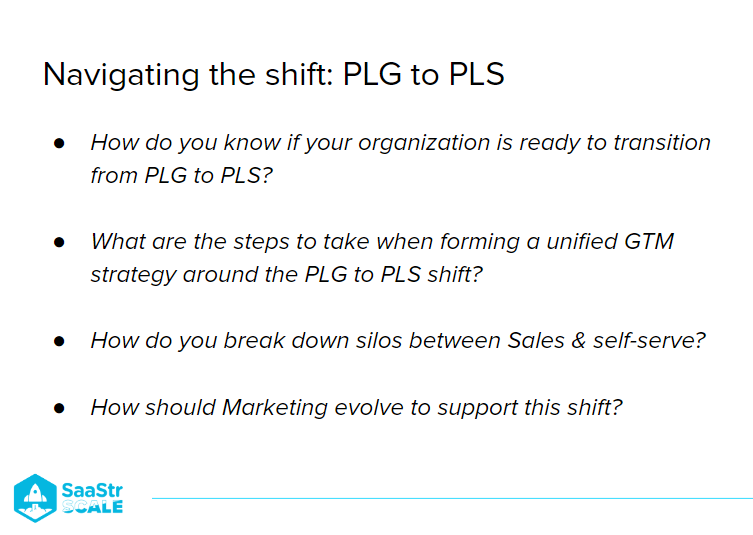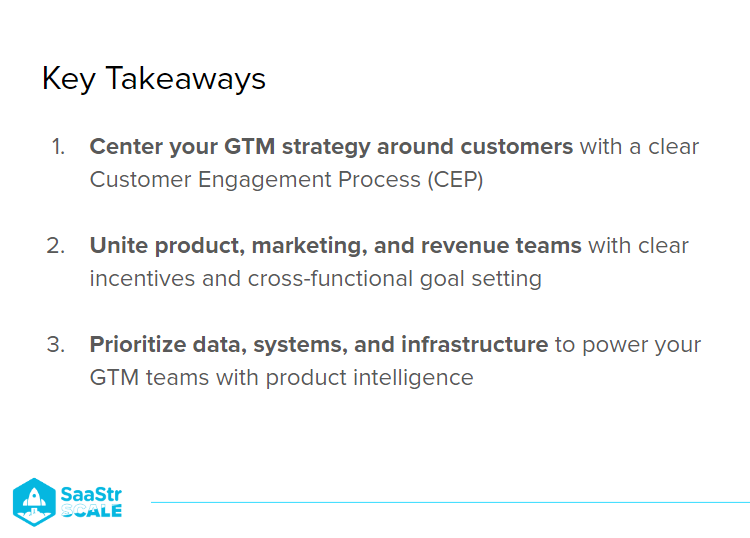In any business, when you have a top-down model with someone at the top making decisions for the entire company, it doesn’t leave a lot of incentive for vendors to create something great. That’s why many companies are shifting from a sales-led to a product-led motion.
Amy Borsetti, GM of Americas at Asana, and Jessica Gilmartin, Head of Revenue Marketing at Asana, share lessons learned from the company’s shift to product-led sales (PLS) — discussing strategies on how to drive cross-functional alignment, break down silos between sales and self-serve and unleash the power of sales and marketing through product-driven insights.
Merging Sales-led and Product-led Motion Is Hard
There’s no getting around it. Evolving from one way of doing something into a completely new way of doing it takes work. So many companies are switching from sales-led to product-led growth, but why?
Product-led growth is about creating a consumer-like experience where you extract a ton of value by coming in with an awesome product where virality can happen and then it grows.
“If you build a product that people love and you define problems that you’re solving for them, you can extract a ton of additional value than just having a sales-led motion,” says Borsetti.
In the top-down model, you have an economic buyer and mobilizers making this investment. It’s a huge change management process when you don’t have a lot of users in the product already.
“With a product-led growth model, you have to earn your right every day to be used as a company,” says Gilmartin.
By blending these two ideas of sales-led and product-led growth, a great marriage can happen between people who love the product and economic buyers. In the long run, it makes it “stickier” because people love it and want it to succeed.
Of course, this is easier said than done. Asana is still in the process of evolving a product-led growth strategy into a product-led sales strategy because they’re part of the same motion and require a lot of iterations to get right.

Product-led Motion De-risks the Revenue Model
It’s easy to see how product-led motion is great for rapid growth. You have the champions, ambassadors, and insiders at these companies who have tried the product, seen its value, and brought it to the decision-makers. There’s no risk in it, which means less resistance.
Allowing people to try a product lets you gather signals for which people are ready to buy, handing you a lot of at-bats. You can leverage data and intelligence coming from the product to create a magical moment for the sales folks down the funnel and even for other companies within the platform.
Those signals, over time, can lead to something great.
Is Your Organization Ready to Transition from Product-led Growth to Product-led Sales
From a readiness standpoint, are you ready to layer on a sales-led motion? It’s an expensive investment, so you want to get it right.
When you’re trying to decide whether your organization is ready to transition from PLG to PLS, two questions you can ask yourself are:
- Can you articulate the problems that you solve, not just for the users but for the users and the economic buyer?
- Which markets, or inside which accounts, are you starting to experience product-led growth?
Let’s break these down a little bit more.
Can you articulate the problems that you solve, not just for the users but for the users and the economic buyer?
You’ll hear a theme from the Asana team — always put the customer at the center, the core, of any thought or action. Not yourself or your product. When you have a product that can solve problems for your customer, and you know precisely how to solve them and talk about them, when you get to a place where you can reckon with that, it’s a wonderful signal.
If you can start to drive value with economic buyers because you’re in with the user, you’ll know how much that sales investment should be and where it makes sense to put your salespeople in terms of a product market fit perspective and sales profile.
Which markets, or inside which accounts, are you starting to experience product-led growth?
And then, when you look at where you’re experiencing product-led growth, you’ll get a better idea of your readiness. If you’re seeing a particular ceiling in segments and have a sticky product in small or mid-market organizations but no virality in the upmarket, that can be a signal.
If you see virality with large customers and can tell they love you and are organically spreading the word, that’s a good sign. That is the moment to bring in a salesperson to harness those champions and create a groundswell of opportunity.
But if you see your primary customers are very small businesses or your product is getting siloed into one team and not spreading, that’s an opportunity to assess your long-term strategy. Determine what you need to do from a product perspective to make it bigger, if that’s the goal, before investing from a sales perspective.
Create a Unifying Go-To-Market Strategy around the PLG to PLS Shift
You must have a unified team if you want a unifying go-to-market strategy. Think expansive! Not just sales and marketing but everyone within the organization needs to be aligned. Building a genuinely cross-functional organization requires a lot of work. Asana is just now getting better at this, which has a nice dash of irony because Asana is all about helping organizations do just that.
Break down silos between Sales and self-serve.
Align on collective goals and make sure everyone is co-creating on those goals — not just across marketing and self-serve, but to product, sales, operations, and everyone else.
To truly align with everyone, you must keep the customer journey at the center of everything you do. That journey is essential, so if you aren’t building around it, you may not be aligned with it.
What does it mean to be a customer, to land, to expand? What does success look like? What are the targets for each team so you can iterate and measure month-over-month to see how you’re getting there collectively while also being able to make the right level of change in the moment?
Using the customer journey as your guidepost allows you to dive into customer outcomes, what they need to achieve at every stage, and how that translates to every role within the company.

It’s Easy to Drive Leads, But Hard to Drive Leads That Sales Is Excited About
Creating the right incentives and ensuring there is complete alignment across the organization is one thing, but creating that level of intelligence about a customer so everyone within the organization is looking at and making the right decisions for the customer based on that information is another.
It’s critical for marketing and sales to be in lockstep, so how does marketing need to evolve to support a product-led growth and sales-led growth motion?
By doing both. It’s marketing’s job to enable virality and expansion, to figure out how to mobilize those champions who have taken a risk on you and love you. Marketing can support product and sales-led growth by giving the sales team the insights, data, and storytelling needed to share the magic of a product with the c-suite, the executives, and economic buyers.
Marketing de-risks the purchase at large organizations and ensures sales have the proof points to make a decision.
Keep Customers At The Center
If you think about the steps in a customer journey, what makes sense at the beginning is very different from what happens at the end. It’s very easy to drive leads. What’s challenging is driving leads that get sales excited.
So the number one priority is making product-qualified leads right from the start. Revenue and sales teams are in concert with marketing about what lead has the highest propensity to move forward. That level of alignment is crucial and often missed because it’s easy for communication to break down.
When everyone across the organization speaks the same language, with the customer at the center every time, alignment becomes easier.
Key Takeaways
- Center your Go-To-Market strategy around customers with a clear Customer Engagement Process. Make sure all teams are aligned on that singular customer journey.
- Unite product, marketing, and revenue teams with clear incentives and cross-functional goal setting — bringing them together and doing the hard work to figure out who you’re targeting and how to measure success.
- Prioritize data, systems, and infrastructure to power GMT teams with product intelligence. The entire organization is responsible for bringing it all together so the sales team knows who to target and what information is needed to be the most efficient and effective at their job.

